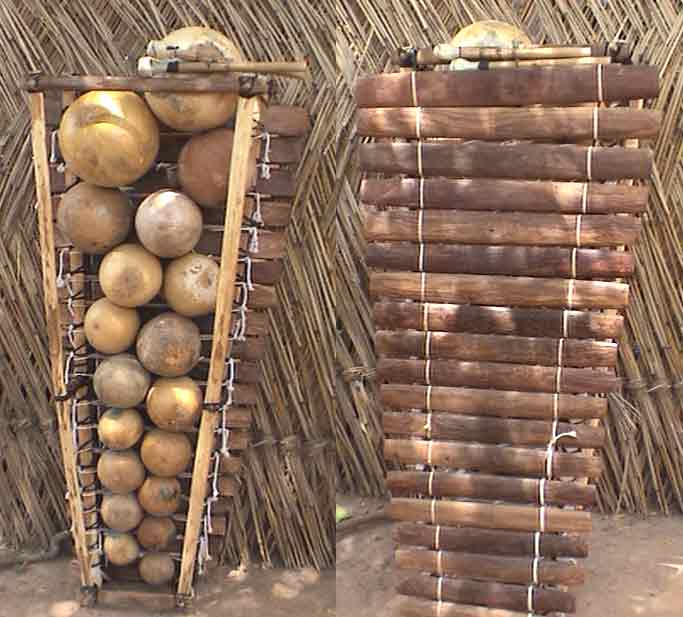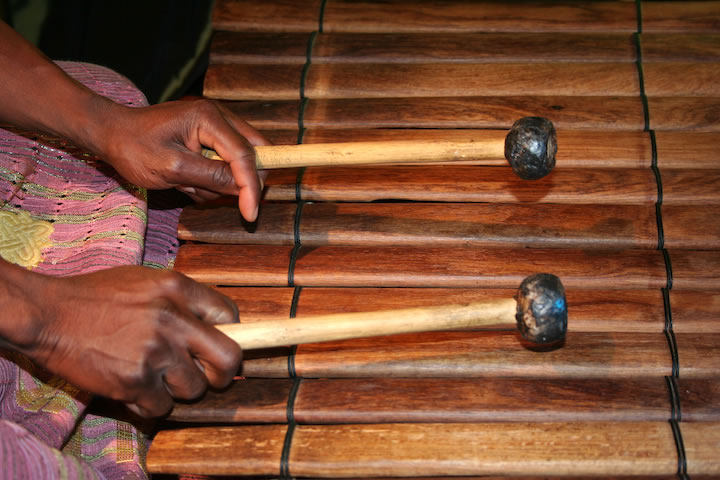
Gert Kilian - Percussion Unlimited
Balafon | Biography | Transmission | Contact | Discography | News | Workshops | Concerts |
» Home
|» MAGIC MALLETS
| » AFROPEAN PROJECT
» LOOPING
» DVD balafon
| » Love
Breeze
| » afro
percussion
» balafon
beat
» new
discs
| » orders
| » reservation
The Balafon |
|
After the discovery of iron and its uses 2,500 year ago, the social organisation
of African society changed. Many of the inhabitants, who had been nomads
since time out of mind, became sedentary. Castes formed, and among them
the blacksmith was found at the centre of all craft activities and became
powerful. Without him there would be no weapons for hunting, nor farming
implements, nor cooking utensils. He was master of fire and wood. Traditionally,
it was he who sculpted the shell of the djembe, or the slats of the balafon.
The balafola's gesture is the same as the blacksmith's. Beating
with the stick is the same movement as with the hammer and the slat replaces
the anvil. Everything seems to indicate that the first balafon players
were smiths. According to one of the Mandingo cosomogonic myths, the first
inhabitant of the Earth coming down from the sky was a blacksmith. It is
certainly not by chance that the balafon played an important part in the
history of the accession of the kingdom of Mali in the 13th century.
At the end of the 12th century, Nare Maghann Konate reigned over
the Mande country, a region that at the time covered today's south east
Mali and north Guinea. Soundiata went into exile with a few faithful followers and travelled all over the country to forge alliances with clan chiefs. Just before his death, Nare Maghann Konate had foreseen this situation. In the south of the country was another kingdom, Sosso. The young Mandingo king, Dankaran Touman, alarmed by the ambitions of his neighbour, sent his Jeli, Bala Faseke to the court of the Sosso King with instructions to try to mediate between the two kingdoms. But Soumaoro Kante imprisoned him and thus violated the ancestral custom of respecting the Jeli. The legend is that it was Soumaoro Kante who met the Dondori imps one day. They showed him an instrument he had never seen before: the balafon! Soumaoro Kante wanted to remain the master of this fantastic instrument. None but he had the right to touch it. If by chance, anyone else played it, he was summarily executed. To emphasise this interdiction, he said, "If a fly lands on it, it shall be found and killed." One day, in defiance of this prohibition, Bala Faseke penetrated the secret room where the balafon was kept and began to play it. Even though he was out in the bush hunting, Soumaoro heard the sound of the balafon. He returned home at once in a rage and was about to kill the Jeli, but Bala Faseke spellbound Soumaoro by singing his praises. He played with such virtuosity that the king was charmed by the music and appointed him as his personal Jeli. War between Soundiata Keita and Soumaoro Kante seemed inevitable. After several inconclusive battles, 1235 saw the battle of Kirina.
In the morning, before hostilities commenced, Bala Faseke succeeded in
fleeing back to his original master, Soundiata Keita. Thanks to the regained
support of his Jeli, Soundiata won the war and became the first "Mansa",
king of Mali. Following the defeat of Soumaoro Kante, Bala Faseke played the balafon during the great ceremonies for a long time. Soundiata named him Bala Faseke Kouyate. That was the foundation of a long line of Griots: the Kouyates, who are still the guardians of this balafon known as the Sosso-Balafon that can be found at Niagassolo, in the north of Guinea. In 2004, UNESCO added the balafon to the world heritage list. Hint: |
 The African balafon |
|
Amongst thousands of percussion instruments, there is an important family, the mallet instruments. Xylophones, vibraphones, marimbas, metallophones, glockenspiels have a common ancestor - the African balafon. The culture of balafon music is highly developed in the countries south of the Sahara desert (Sahel zone) and the tropical rain forest. In the 16th century, it became a real art at the royal court of Sikasso/Mali and was flourishing under the reign of a generous king. Being nourished and housed, the musicians developed virtuosity and founded a music tradition. The balafon consists of wooden mallets and calabashes - hollow pumpkins - serving as resonance-boxes. Their volumes correspond to their notes. There are two or three holes in each calabashe, covered by spider webs or bat wings, nowadays more and more by ...cigarette-paper. These membranes vibrate with the resonance, which creates a rustling sound, a so-called mirliton effect. This effect is accentuated by the sound of metal bracelets attached to the player's wrist. Mallets and resonators are fixed on a frame of wood sticks and strings made of goat's skin. In Guinea, Nigeria, Chad and Kenya are the pit-resonated xylophones.
The slats are placed over holes dug in the ground. The Makonde, Wayao and
Wazaramo people in Tanzania play a type of marimba with one large
resonator. In Eastern Cameroon, the ethnic Fang play with six mendjans,
xylophones with different registers (bass, alto, tenor, soprano) that make
up a real orchestra, the komendjan. The Fangs in Gabon play the
mendjan me biang. The Bamileke, people from the north-west of Cameroon
play the djein, a xylophone with big slats laid across banana trunks.
In Chad, the Sarah and Sarakabas play the kundu xylophone. In the
Republic of Congo, the Balubas use the madimba and in Mozambique,
the Chopi people play the timbila. The ethnic Ibos in Nigeria have
a xylophone with one single slat. In Uganda, they play the amadinda
xylophone which has 12 slats; played by three musicians, two on one side,
one on the other. They also have the akadinda xylophone with 22
slats, which is played by six musicians, three on each side. There you
find as well the big xylophone embaire, played by the Basogas. Normally, the balafon is tuned from the lowest to the highest note, usually in a pentatonic chord (five tones), like, for example, the black mallets on a piano keyboard. Nowadays, "western" chords can be found as well, like diatonic and chromatic. But at all times, African musicians have known how to cope with influences coming from abroad in an own, original style. © Gert Kilian, 2008
|
![]()
Balafon | Biographie | Transmission | Contact | Discographie | News | Stages | Concerts
